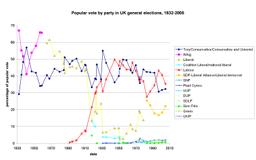The United Kingdom general elections overview is an overview of United Kingdom general election results since 1922. The 1922 election was the first election in the new United Kingdom of Great Britain and Northern Ireland, after the creation of the Irish Free State removed Southern Ireland from the UK.
1979–2010[?]2015,2017
The last thirty years saw just five prime ministers, with Margaret Thatcher and Tony Blair the two longest serving post-World War II prime ministers in the UK (the other prime ministers during this period being John Major, Gordon Brown and David Cameron). There was also a mini-revival of the Liberal Party which, after a merger with the Social Democratic Party became the Liberal Democrats and increased their seats in parliament from 11 in the 1979 election to 62 in 2005. The outcome of the 2010 election brought about the first hung parliament since 1974 and forced the victorious Conservative Party to accept the Liberal Democrats as their coalition partner.
Voter turnout also fell during this period, with the 2001 election seeing a post-World War II low of 59.4%. In Northern Ireland, the Good Friday Agreement has led to a vast reduction in conflict, though the moderate parties who gained power in the 1980s, such as the Ulster Unionist Party, have been replaced as the dominant powers by the likes of Sinn Féin and the Democratic Unionist Party. The elections of the 1990s and 2000s (decade) also saw an increased proliferation of smaller parties, with more parties standing at the 2005 general election than ever before.
1955–1974
The elections of this period took place in the context of the decolonialisation of the British Empire and the UK's declining status as a Great Power. It also saw the UK enter the European Union and some periods of high unemployment. The early years of the period saw Conservative consolidation of power, before Harold Wilson's two general election wins in 1964 and 1966. There was then a series of close fought elections, including two in 1974. This period was also the one in which the Liberal Party was at its all-time low, never having more than 14 seats (though it had been in 1951 when they'd had their lowest ever percentage of the vote).
The Ulster Unionists dominated in Northern Ireland, whilst the Scottish National Party and Plaid Cymru became major players for the first time, the SNP gaining 11 seats in 1974. This period also saw the demise of the autonomous Scottish Unionist Party, when it merged with the Conservative Party.
1929–1951
This era saw massive social change in the UK, going through the Great Depression of the 1930s, the national government of the Second World War and the socialist Labour government of Clement Attlee. The Labour party gained a landslide victory in 1945, contrasting with the pre-war dominance of the Conservative Party. This was also the period of the Liberal Party's major collapse, with their split into the Liberal and National Liberal parties (the National Liberals eventually joined the Conservatives) and the completion of Labour's rise to power.
1929 also saw the first Scottish and Welsh nationalist candidates.
1922–1924
In the years after the secession of the Irish Free State, the Conservatives led the House of Commons, followed by a surging Labour Party and a declining Liberal Party. The Communist Party of Great Britain also enjoyed their most prolonged period of success, though still failed to have more than 1 MP at any time.
